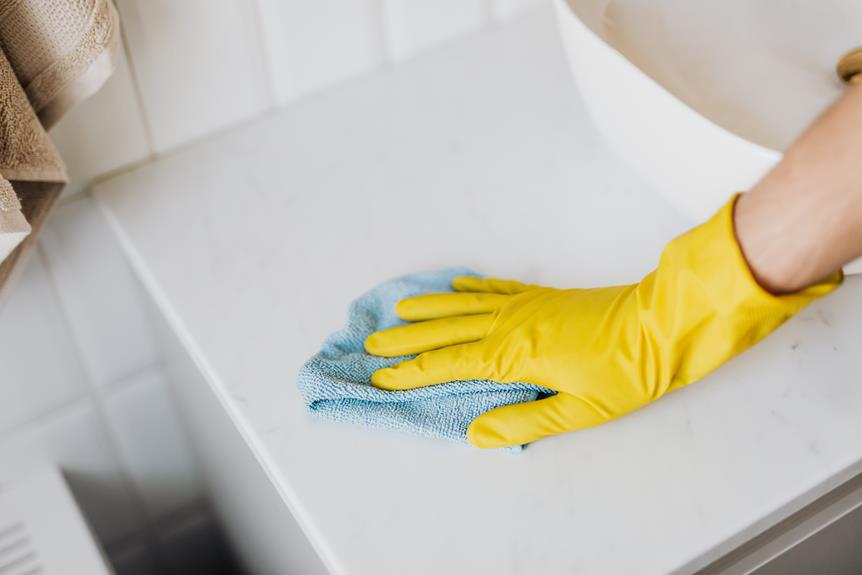When it comes to choosing between microfiber and microsuede, you want to know which fabric is superior in terms of durability, softness, and style. Both fabrics have their own unique characteristics and benefits, making it essential to understand the differences between them.
In this comparison, we'll explore the fabric composition, durability and maintenance, softness and texture, pet-friendliness, style and aesthetics, and price and affordability of microfiber and microsuede.
By the end, you'll have a clear understanding of which fabric best suits your needs and preferences.
Key Takeaways
- Microfiber and microsuede are both durable fabrics, but microsuede tends to be more resistant to wear and tear.
- Microfiber offers a plush feel and is ideal for cozy furniture, while microsuede provides a more authentic suede-like texture and adds sophistication to furniture and clothing.
- Microfiber is more prone to attracting pet hair, while microsuede's dense weave makes it less likely to trap pet hair.
- Microfiber is more versatile in terms of design aesthetics, while microsuede adds a touch of elegance to a room's decor.
Fabric Composition
When comparing microfiber and microsuede, you should consider the fabric composition to understand their differences and performance.
Microfiber is made of finely woven synthetic fibers, usually polyester and nylon, which give it a soft, lightweight, and breathable feel. On the other hand, microsuede is a type of microfiber with a brushed finish to resemble suede leather, usually composed of polyester.
Understanding the fabric composition is crucial for fabric care and stain resistance. Microfiber's composition allows for easy cleaning and maintenance, as it's often machine washable and dries quickly, making it an ideal choice for busy households. Its tight weave also provides excellent stain resistance, making it suitable for furniture upholstery and household items.
Microsuede, with its brushed texture, requires more delicate fabric care, usually only spot cleaning and gentle brushing. While it offers good stain resistance, it may require more attention and maintenance to preserve its luxurious appearance.
Considering the fabric composition is essential in determining the fabric care and stain resistance capabilities of microfiber and microsuede.
Durability and Maintenance
When it comes to durability, microfiber has the advantage with its tightly woven fibers that resist wear and tear.
On the other hand, microsuede is known for its ease of maintenance, as it can typically be cleaned with a simple wipe or vacuuming.
Understanding the differences in durability and maintenance between these two fabrics can help you make an informed decision for your furniture or upholstery needs.
Microfiber's Durability Advantage
You can easily maintain the durability of microfiber by following simple care instructions. It offers exceptional fabric longevity when properly cared for, making it a wise investment for your furniture.
Additionally, microfiber's stain resistance is a game-changer, ensuring that your furniture remains looking pristine for longer periods. With a wide range of color options available, you can select the perfect shade to complement your interior design, without worrying about it fading over time.
By regularly vacuuming and using a mild soap and water solution for cleaning, you can ensure that your microfiber furniture maintains its durability and aesthetic appeal.
This fabric's ability to withstand wear and tear makes it an ideal choice for those seeking long-lasting and low-maintenance furniture options.
Maintenance Ease of Microsuede
To maintain the durability of microsuede, regularly vacuum and use a mild soap and water solution for cleaning, ensuring its longevity and aesthetic appeal.
Microsuede is known for its exceptional stain resistance, making maintenance relatively easy. When spills occur, blot them immediately with a clean cloth to prevent the liquid from soaking into the fabric.
Regular vacuuming with a soft brush attachment helps to prevent dust and debris from settling into the fabric. For more stubborn stains, a gentle cleaning solution can be made using mild soap and water, ensuring not to saturate the fabric.
After cleaning, allow the microsuede to air dry completely.
Softness and Texture
When it comes to softness and texture, microfiber offers a plush feel that's often likened to that of suede, while microsuede provides a more authentic suede-like texture.
The softness and texture of these fabrics can greatly impact your comfort and overall satisfaction with your furniture or clothing.
Understanding the differences between microfiber and microsuede in terms of softness and texture can help you make an informed decision when choosing between the two.
Microfiber's Plush Feel
For experiencing the plush feel of microfiber, run your hand across the fabric to appreciate its softness and texture. When you do so, you'll immediately notice the plush comfort that microfiber offers, making it an ideal choice for cozy furniture and luxurious throws.
The luxurious texture of microfiber creates a sensory experience that's unmatched, evoking a sense of indulgence and comfort. The gentle, velvety touch of microfiber against your skin provides a soothing sensation, elevating your relaxation to a whole new level.
As you sink into a microfiber-covered sofa or wrap yourself in a microfiber blanket, you'll be enveloped in a cocoon of softness that's both opulent and comforting, making it the perfect fabric for those who appreciate the finer things in life.
Microsuede's Suede-Like Texture
Experiencing the softness and texture of microsuede involves running your hand across the fabric to appreciate its suede-like feel, providing a luxurious sensory experience similar to microfiber.
Microsuede's suede-like appearance offers a sophisticated and elegant aesthetic, making it a popular choice for furniture and clothing.
The material's plush and velvety texture adds a touch of luxury to any item it adorns, creating a cozy and inviting atmosphere.
Additionally, microsuede's stain resistance is a remarkable feature, making it a practical option for everyday use. This characteristic ensures that spills and stains can be easily wiped away, maintaining the fabric's pristine appearance.
Whether you're seeking comfort, style, or durability, microsuede's suede-like texture surpasses expectations, offering a blend of luxury and practicality.
Pet-Friendliness
Looking after pets involves considering their interactions with furniture, making it important to understand how microfiber and microsuede fabrics fare in terms of pet-friendliness. When it comes to pet-friendliness, both microfiber and microsuede have their pros and cons to consider:
- Pet Hair: Microfiber tends to attract pet hair and can make it difficult to remove, whereas microsuede's dense, tight weave makes it less likely to trap pet hair, making it easier to clean and maintain.
- Stain Resistance: Microfiber is known for its excellent stain resistance, making it easier to clean up after pet-related accidents. On the other hand, microsuede may not be as stain-resistant, and pet-related spills or accidents could leave lasting marks.
It's clear that both fabrics have their strengths and weaknesses when it comes to pet-friendliness. While microsuede may be better at resisting pet hair, microfiber has an edge in terms of stain resistance. Consider your pet's habits and your own cleaning preferences when choosing between the two fabrics for your furniture.
Style and Aesthetics
When choosing furniture, consider the style and aesthetics of microfiber and microsuede fabrics to determine which best suits your preferences and decor. Both microfiber and microsuede offer a wide range of color options, making it easy to find a shade that complements your existing interior design or personal taste.
Microfiber often has a slightly more textured appearance, while microsuede tends to have a smoother, suede-like finish. This difference in texture can impact the overall look and feel of the furniture, so it's important to consider which style aligns with your aesthetic preferences.
In terms of design versatility, microfiber and microsuede both offer a variety of options that can suit different decor styles. Microfiber tends to be more adaptable to different design aesthetics due to its texture and sheen, while microsuede's soft, luxurious appearance can add a touch of elegance to a room.
Ultimately, the choice between microfiber and microsuede comes down to personal style and the specific look you want to achieve in your space. Whether you prefer the versatility of microfiber or the luxurious feel of microsuede, both fabrics offer stylish options for your furniture.
Price and Affordability
To determine which fabric offers better value for your budget, consider the cost and affordability of microfiber and microsuede. When comparing the price and affordability of microfiber and microsuede, it's essential to take into account various factors that can influence your purchasing decision.
Here's what you should consider:
- Fabric longevity:
- Evaluate the lifespan of the fabric. While microsuede may initially seem more expensive, it tends to be more durable than microfiber, meaning it may offer better value in the long run due to its longevity.
- Consider the cost in relation to the fabric's durability. A higher initial cost for microsuede might be justified by its ability to maintain its quality over time, potentially saving you money in the long term.
- Environmental impact:
- Assess the environmental impact of both fabrics. While microfiber is often more affordable, it may have a higher environmental cost due to its synthetic nature and shedding of microplastics.
- Factor in the potential need for replacement. A cheaper upfront cost for microfiber may be offset by the need to replace it sooner, contributing to more waste and higher long-term costs.
Considering fabric longevity and environmental impact alongside initial cost can help you make a well-informed decision that aligns with your budget and values.
Frequently Asked Questions
Can Microfiber or Microsuede Be Used for Outdoor Furniture?
Yes, both microfiber and microsuede can be used for outdoor furniture. They offer good outdoor durability and come in a variety of color options, allowing you to customize your outdoor space to your liking.
What Are the Environmental Impacts of Producing Microfiber and Microsuede Fabrics?
When considering the environmental impact, it's crucial to understand that both microfiber and microsuede production processes have potential drawbacks. The manufacturing process can involve energy-intensive methods and chemical treatments, leading to environmental implications.
Are There Any Health Concerns Associated With Using Microfiber or Microsuede Fabrics?
Using microfiber or microsuede fabrics may pose health concerns for those with fabric allergies. Both fabrics can trap allergens and require regular cleaning. Be mindful of potential skin irritations and respiratory issues when using these fabrics.
Can Microfiber or Microsuede Be Easily Dyed or Customized?
You can easily customize both microfiber and microsuede through custom dyeing. This process allows you to tailor the fabric to your preferences, making it an excellent choice for those seeking personalized textiles for their home or clothing.
Are There Any Unique Care Instructions for Cleaning and Maintaining Microfiber or Microsuede?
To keep your microfiber or microsuede looking great, use specialized cleaning products and techniques. Regularly vacuum and use a soft brush to prevent stains. Consider applying a fabric protector for additional stain prevention.
- The Use of Nonwovens in Construction and Civil Engineering - July 11, 2025
- The Use of Nonwovens in Construction and Civil Engineering - July 11, 2025
- The Use of Nonwovens in Construction and Civil Engineering - July 11, 2025







